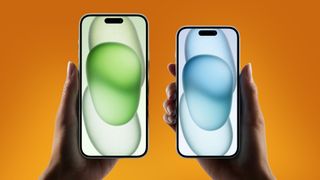Your phone, your identity: safeguarding your device from the threat of identity theft
If your smartphone is stolen, it can provide an easy entry point to your entire digital life for a criminal

Every day, you add more and more information to your phone. Each day, it becomes a more complete digital representation of you. Bank accounts, the PayPal app, even password managers - they're all there, along with social media accounts, photos … the list goes on.
The implication is clear. Your phone represents a massive risk to your privacy and your identity. Once stolen, a phone can be mined for data that can be used to steal your identity, making you a victim of ID fraud.
<a href="https://aurainc.sjv.io/c/221109/899264/12398?subId1=hawk-custom-tracking&sharedId=hawk&u=https%3A%2F%2Fbuy.aura.com%2Fsave-50" data-link-merchant="buy.aura.com"">A Techradar Choice for Best Identity Theft Protection Aura is an excellent choice thanks to its user friendly interface, antivirus service and detailed reporting dashboard. <a href="https://aurainc.sjv.io/c/221109/899264/12398?subId1=hawk-custom-tracking&sharedId=hawk&u=https%3A%2F%2Fbuy.aura.com%2Fsave-50" data-link-merchant="buy.aura.com"" data-link-merchant="buy.aura.com"">Save up to 50% with a special Techradar discount.
Protect your smartphone from theft
The first step in minimizing identity theft via your smartphone is to make it difficult to steal.
To begin with, don't leave a phone on view in your car. Instead, use a glove compartment or slip it under a seat. Then, if the phone is out of sight, it isn't a target. The same goes for any device storing personal, identifiable data.
On the street, keep your phone out of view. Don't wave it around; secure it in the inside pocket of your coat. Otherwise, save it in a secure pouch in your bag, worn securely. Use hands-free Bluetooth earphones to avoid removing the phone to make or receive calls.
You should also be aware of the tactics of street criminals when it comes to stealing phones. They have various tactics to ingratiate themselves into your personal space and help themselves to your belongings. Key examples:
They ask you for the time. While your initial reaction would be to pull out your phone to check, this puts it at risk. So, instead, identify a clock you see from your location or keep moving without responding.
Are you a pro? Subscribe to our newsletter
Sign up to the TechRadar Pro newsletter to get all the top news, opinion, features and guidance your business needs to succeed!
You're accosted in a crowded place. This can happen without even realizing it. A key example is a moment on a tube train when people enter and exit, dozens pushing past you all at once. It's a prime opportunity, so keep your phone out of view.
While many of these practices are completely obvious, it is crucial to keep them in mind.

Protect your smartphone secrets
Next, you must ensure that if your phone is stolen, it doesn't reveal anything an identity thief can use. Various tools and apps can ensure your phone doesn't spill your secrets.
1. Encrypt your phone
Use your phone's full disk encryption option to ensure that data cannot be accessed without the correct authentication. All mobile platforms have an encryption option, so take the time to find out how to activate this. If you forget the phone's password, the data cannot be retrieved once encrypted.
2. Secure authentication
Most phones offer facial recognition, a thumbprint scanner, or the option to enter a secure password. Avoid four-digit PINs and shapes, as these leave a grease mark on the screen, which can be used to crack the code. For convenience and reliability, fingerprint or thumbprint security has proved to be the most effective.
3. Use an app-locking tool
If your phone is stolen and access gained, some apps (such as contacts, email, cloud drives, and social networks) will spill your secrets as soon as they're launched. You can set individual passwords for sensitive apps with an app lock installed. You've probably realized this might prove inconvenient in some scenarios, but overall, it is a good security option.
4. Install an anti-theft app
Tools that detect a change in circumstance can initiate an anti-theft alarm. For example, if a phone is taken off charge, moved, or the SIM card changed without authorization, it can trigger an alarm. Such apps typically feature the option to disarm the alarm or even send it silently, advising a nominated contact (or all of them) that the phone has been stolen.
5. Find and wipe a stolen phone
Find My Device on Android and Find My for iPhone can be used to wipe a stolen phone remotely. Apps like Cerberus and Prey can also do this and photograph the perpetrator using the phone's camera. If your phone is stolen, you can destroy the data remotely via a web app.
All these tools can be used to protect your phone from unauthorized access. If you're reluctant to utilize any of them, use disk encryption and your platform's phone discovery service.
Be aware of phone account identity theft
A whole other type of identity theft surrounds mobile phone use. Phone account identity theft occurs when a cell phone is bought in your name without your knowledge. You might have been a victim of this, or your address might have been used with another person's name. This is a common tactic to use a superior credit rating and acquire finance to buy a phone.
Phone account fraud happens by stealing a victim's identity in one of two ways:
- Dark Web sites with databases full of stolen account details are visited, details bought, then used to buy a phone, with the bills all charged to the victim.
- Phishing can be employed to trick the victim into divulging personal details required to open an account. These are then taken to a smartphone retailer, accompanied by a fake ID and a phone bought.
This type of identity theft you should be able to spot quickly. When the account statement arrives, get in touch with the mobile phone network and report the contract as fraudulent.

Shield your identity from theft - secure your phone
With so much of your personal information in your pocket, it makes sense to understand the risks and take precautions to secure your phone.
By now, it should be obvious that protecting your phone is a crucial step in the fight against identity theft. So follow these steps to ensure it never leaves your sight, remains utterly secure from unauthorized access, and doesn't leak your data to identity thieves.
More from TechRadar Pro
- Protect your devices online with the best antivirus software
- These are the best mobile VPN apps around
- We've put together a list of the best password managers
- We've also highlighted the best identity theft protection
Bryan M. Wolfe is a staff writer at TechRadar, iMore, and wherever Future can use him. Though his passion is Apple-based products, he doesn't have a problem using Windows and Android. Bryan's a single father of a 15-year-old daughter and a puppy, Isabelle. Thanks for reading!


